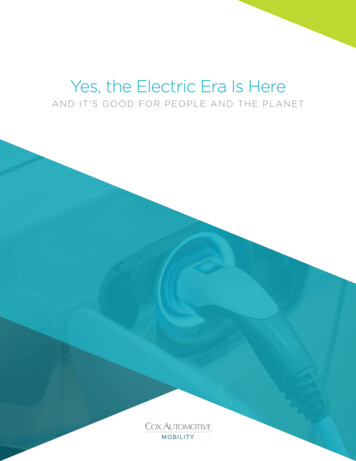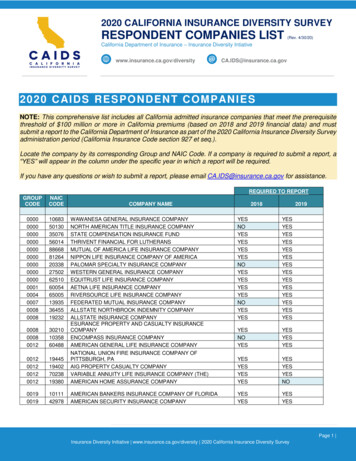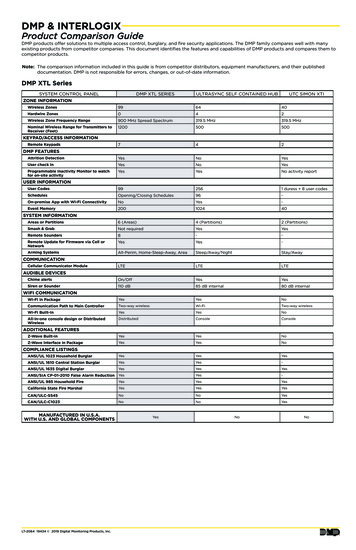
Transcription
Yes, the Electric Era Is HereAND IT’S GO O D FO R P E OP L E A N D T H E P L A N E T
TABLE OF CONTENTS02Introduction02 The Three Levels of Electrification03What’s Driving the Electric Vehicle Revolution06Good for the Planet: Electric Vehicles Are Cleaner From Cradle to Grave06 Manufacturing Phase09 Use Phase11 End-of-Life Phase12Greener Fleets14Consumer & Dealer Perceptions16Good for People: Cleaner Air, Better Health and a Planet That Endures17Ride the Wave of the Electrification Revolution17Key TakeawaysStephanie Valdez StreatyDirector of Research & Development,Cox Automotive MobilityAs the Research & Development Director for Cox Automotive Mobility, Stephanie is responsiblefor exploring new business models across the ACES (Autonomous/Aerial, Connected, Electric,Shared) portfolio of transportation. Her focus also includes developing external partnerships tocreate and implement a high-voltage battery ecosystem in support of Cox Automotive Mobility’sglobal EV Battery Services division.Previously, Stephanie was the Senior Director of Corporate Responsibility for Cox Automotive,where she was responsible for building and executing the sustainability strategy across thecompany. In addition to her management of the sustainability program, Stephanie also managedthe corporate Go Green Council and Local Green Teams.Stephanie is a board member of EarthShare of Georgia and the Georgia Tech Ray C. AndersonCenter for Sustainable Business Advisory Board, as well as a graduate of the Institute for GeorgiaEnvironmental Leadership program.Stephanie graduated from Stanford University with a bachelor’s degree in sociology andorganizational development.01
INTRODUCTIONElectric vehicles have a long history, but the era for mass production and practical long-rangecustomer use is upon us only now. Still considered by the general public as an emergingtechnology, it’s not surprising confusion, skepticism, and even doubts persist. Misinformationand half-truths make it difficult to discern actual facts and some even claim that electric vehiclesaren’t living up to their “green” hype in one way or another.While asking questions is productive during this period of change, it’s important to recognizethat we are at the beginning of end of the Oil Age in cars and trucks. A perfect storm ofenvironmental commitments, greater OEM offerings, and changing consumer sentiments aredriving electrification.THE THREE LEVELS OF ELECTRIFICATIONHybrid Vehicleaka Hybrid ElectricVehicle or HEVPlug-In Hybrid Vehicleaka Plug-in Hybrid ElectricVehicle or PHEVElectric Vehicle aka BatteryElectric Vehicleor BEVSwitches between a gasengine and an electric motorfor higher gas mileage;no plug-in charging. Thebattery pack that suppliesthe motor is charged by thegas-powered engine andregenerative brakes.Runs on electricity first, withthe gas engine used as backup. Batteries can be chargedusing a wall outlet orcharging station or by thegas-powered engine orthrough regenerative braking.Doesn’t use a gas-poweredengine at all; runs on batterypower only. The battery ischarged using a wall outlet orcharging station or throughregenerative breaking.The best option for theenvironment over its life cycle.02
WHAT’S DRIVING THE ELECTRICVEHICLE REVOLUTIONEnvironmental Commitments – The U.S. Rejoining the Paris AgreementThe U.S. has lagged Europe and China on mass adoption of electricvehicles, but 2021 marked a dramatic change on the policy front.President Biden announced on the first day of his presidency that the U.S.would rejoin the Paris Agreement, with a focus on electric vehicles andcharging infrastructure. The U.S. officially rejoined the Paris Agreement onFebruary 19, 2021.The Paris Agreement brought all nations together — including the topemitters of greenhouse gases — in 2015 to fight the climate crisis. The goalof the Paris Agreement is to hold global temperature rise to “well below 2,preferably to 1.5 degrees Celsius, compared to pre-industrial levels” and cut netgreenhouse gas emissions to zero by mid-century.1The U.S. has committed tocutting emissions by50% - 52%below 2005 levels by 2030.Each country sets its own non-binding emissions reduction targets and outlines the actions theywill take to meet them. This year, countries submitted their goals for 2030 and their plans to getthere. The U.S. has committed to cutting emissions by 50% – 52% below 2005 levels by 2030.2The Paris Agreement is a powerful signal to businesses that the nations of the world arecommitted to curbing emissions and accelerating the transition to a clean energy economy. Itdrives public policy and is a clarion call for companies — particularly automakers — to embracerenewable energy. Especially since the transportation sector is the largest source of emissions inthe U.S., most of which comes from cars and trucks.31“The Paris Agreement.” United Nations Framework Convention on Climate Change. 2015.2 “President Biden Sets 2030 Greenhouse Gas Pollution Reduction Target Aimed at Creating Good-Paying Union Jobs and Securing U.S. Leadership on Clean Energy Technologies.”The White House Briefing Room. April 22, 2021.3“Carbon Pollution from Transportation.” U.S. Environmental Protection Agency, www.epa.gov.03
Switching from gasoline to electricity is a vital part of reducing emissions and avoiding the worstimpacts of climate change. However, it’s only one of many solutions. For example, you can plugleaks in your home insulation to save power, install a smart thermostat, switch to more efficientlight bulbs, waste less food, and eat less meat. But, switching to an electric vehicle could be oneof the biggest actions a household can take to reduce their carbon footprint, considering theaverage passenger vehicle emits 4.6 metric tons of carbon dioxide per year, according to theEnvironmental Protection Agency.Setting the Stage for an All-Electric FutureClimate experts agree that vehicle electrification is one of the best ways to reduceplanet-warming greenhouse gas emissions. Here are the key factors driving OriginalEquipment Manufacturers (OEMs) to provide greener mobility solutions: Government Regulations and Incentives – More stringent carbon dioxide emissionregulations—particularly in overseas markets—along with incentives and subsidies that supportelectric vehicle investment promotion and sales. Different countries (and states) are in differentstages of enacting limits on gasoline and diesel-powered vehicles, but the trend is clear: if youwant to be part of the future in the biggest automotive markets you need to have a transitionplan from petroleum to electric vehicles. Infrastructure and Technology Development – President Biden’s infrastructure proposal aswell as bipartisan compromises allocate billions of dollars toward a national electric vehiclecharging network. Plus, Wall Street is getting into the act; electric car charging companies likeChargePoint Holdings (NYSE: CHPT), EVgo Services, Blink Charging, and Beam Global lookto profit from deploying more public charging stations across the U.S. Although most electricvehicle owners currently charge up at home, more charging stations will alleviate consumeranxiety about running out of power on long-distance trips. In addition, technological advancessuch as greater battery capacity, life and performance, and faster charging times are helping toaccelerate adoption. Consumer Readiness – The mobility industry has been responding to the demand for highersustainability for many years, and the electric vehicle is part of the solution. Today, the generalpublic has a greater awareness of the environmental impact of fossil fuels.4 A recent ConsumerReports survey showed that seven out of ten consumers are interested in getting an electricvehicle in the future.5Quite simply, electric vehicles offer a pathway toa sustainable transportation future that fossilfuel-powered vehicles cannot. As a result,automakers are shifting to electric vehicles, whichare projected to make up 25 percent of new U.S.sales by 2035 and 60 percent of new sales in 2050according to research firm IHS Markit.4 “From climate change awareness to action.” International Institute for AppliedSystems Analysis. ScienceDaily, March 9, 2020.5“ New CR survey finds the majority of consumers are interested in getting an electricvehicle.” Consumer Reports, December 2020.04
OEMs Providing More Electric Vehicle OfferingsMyth: There aren’t a lot of electric vehicle options available.As a leader in electric vehicle sales, it’s no surprise that Tesla gets the lion’s share of mediaattention. The introduction of the Tesla Model S in 2012 changed many people’s impression ofwhat an electric car is.While Tesla has been a game changer, there are many more affordable electric vehicles in themarket, though they tend to get much less press coverage. In fact, during the first half of 2021,consumers saw 19 new models entering the market in the U.S.6 Almost 100 electric vehiclemodels are set to debut in the U.S. by the end of 2024, according to Consumer Reports.American car shoppers can now find electric vehicles across a range of prices and automakers.For model year 2022, there will be fifteen mass-market electric vehicles launched (according toKelly Blue Book). And that’s just the beginning. Automakers and parts suppliers have announcedplans to spend over 400 billion by 2025 on boosting the use of electric vehicles, with aggressivecommitments for an all-electric future.7General Motors says it will make only electricvehicles by 2035. Ford expects electricvehicles to make up almost half of its globalsales by 2030. Volkswagen says 70% of itsEuropean sales and 50% of its U.S. sales willbe electric by 2030. Jaguar plans to sell onlyelectric cars by 2025. Volvo plans 50% of itsglobal sales to be all-electric by 2025. Stellantisexpects 40% of its U.S. sales to be either fullyelectric or plug-in hybrid within four years.BMW expects roughly half of its global salesto be electric vehicles by 2030. By 2022,Mercedes-Benz will have battery electricvehicle offerings in all segments. Nissantargets 40% full battery electric vehicle salesin the U.S. by 2030. Hyundai will phase outcombustion engines in most major marketsby 2040. Amongst the hybrid pioneers,Honda expects to ditch gas-powered vehiclescompletely by 2040, with Toyota introducing15 all-electric vehicles by 2025.6 “12 Best Selling Electric Vehicles of 2021 (so far).”caranddriver.com. July 19, 20217 “Letter to President Joseph R. Biden, Jr.” Alliance forAutomotive Innovation. March 29, 2021.05
Electric vehicles are the real deal: much cleaner than traditional, gas-powered, internalcombustion engine (ICE) vehicles; better for the planet and our collective health; and betterfor our wallets, especially over the long haul. From cars to buses to trucks, electric vehicles aresaving the climate and our lives. Here’s how.GOOD FOR THE PLANET: ELECTRIC VEHICLESARE CLEANER FROM CRADLE TO GRAVEThe automotive industry is making the shift from a take-make-waste extractive industrialmodel to a circular economy focused on positive society-wide benefits. That meansenvironmentally friendly vehicles along their entire lifecycle—from green production usingrenewable energies to responsible battery disposal and chemical recycling. Electric vehiclesare a big step in that direction.It’s not that electric vehicles are perfect; it’s just that they have a significantly smaller carbonfootprint than gasoline-powered cars and that gap is widening. Electric vehicle technology hasadvanced quickly in recent years, yet the limits of early technology are still named as issuestoday. Let’s debunk some of the myths about electric vehicles and set the record straight.The life cycle of vehicle emissions has three phases: the manufacturing phase, the use phase, andthe end-of-life phase.MANUFACTURING PHASEGreener BatteriesMyth: Electric vehicles are worse for the climate than gasoline-powered cars because ofbattery manufacturing.It’s true that electric vehicles are more emissions-intensive to make than traditional cars becauseof their lithium-ion batteries; Battery production uses a lot of energy, from the extraction ofraw materials to the electricity consumed in manufacturing. According to a studyby researchers at the Argonne National Laboratory, some ways of producinglithium are more green than others. The results show that concentratedlithium brine and its related end products can vary significantlyin energy consumption, greenhouse gas emissions,sulfur dioxide emissions and water consumptiondepending upon the resource allocationmethod used.06
But, despite producing more emissions during the battery productionstage, electric vehicles are still better for the environment thangas-powered cars over the course of their life cycle. According toBloombergNEF, the carbon emissions from building the average 2020model electric vehicle is about equal to the car making and burninggasoline associated with driving the average 2020 model ICE vehicleapproximately 17,000 miles. But after that point, the electric vehicle isgreener by leaps and bounds over the lifespan of a typical car.Electric vehicles soldtoday produceless than halfthe global warmingemissions of comparablegas-powered vehicles.In fact, the average electric vehicles sold today produce less than half theglobal warming emissions of comparable gas-powered vehicles, even when thehigher emissions associated with electric vehicle battery manufacturing are taken intoconsideration.Mine-to-Wheel Life Cycle Global Warming Emissions of Different Passenger Vehicle TypesSource: Ambrose, Hanjiro and JimmyO’Dea. 2021. “Electric Vehicle Batteries:Addressing Questions about CriticalMaterials and Recycling.” Cambridge,MA: Union of Concerned Scientists.February 11, 2021.Moreover, researchers say that electric vehicle batteries are cleaner today than they were evena few short years ago.8 And the batteries keep getting cleaner. Analysts expect battery packenergy densities to increase another 15% over the next decade.9This improved technology can:1. Extend the range a vehicle can travel before needing to plug in again, given the samebattery size or2. S hrink the size of the battery pack, resulting in greater efficiencies and additionalcost savings.8 Erik Emilsson, Lisbeth Dahllöf. “Lithium-Ion Vehicle Battery Production: Status 2019 on Energy Use, CO2Emissions, Use of metals, Products Environmental Footprint, and Recycling.” IVL Swedish EnvironmentalResearch Institute. ISBN 978-91-7883-112-89 “By 2030, Battery Electric Vehicles will be Less Reliant on Lightweighting: Increasing battery packenergy densities holds the key to future vehicle design.” Lux Research, Inc. November 12, 2020.07
WHAT IS BATTERY ENERGY DENSITY? It’s how much energy a battery contains in proportionto its weight. A battery with high energy density has a longer battery run time compared toother batteries of the same size. Alternately, a battery with high energy density can deliver thesame amount of energy, but in a smaller footprint. Basically, it means that the lithium-ion batteryin electric vehicles—the heaviest component—is getting smaller and more efficient. It’s alsobecoming less costly—another win for consumers.Source: Flux PowerWhat’s more, producing batteries in regions with relatively low-carbonelectricity or in factories powered by renewable energy is alsosubstantially reducing battery emissions. Plus, the extra emissionsassociated with battery production are rapidly offset by thereduced emissions from merely driving.Greener MaterialsLightweighting, or purposely designing more lightweight cars specifically for fuel efficiency, hasbeen a key tool for improving the fuel economy of conventional vehicles. That’s because theacquisition, processing, and transport of heavier materials to produce the vehicle componentsgenerate higher emissions.Fortunately, electric vehicles are already overwhelmingly more efficient than conventional cars,due to regenerative braking and more powerful motors. But smaller, more efficient batteriesand newer, lightweight body design advances are further cutting down electric vehicle weightfor an even greener ride. According to Lux Research, Inc., automakers are also shifting to otherclimate-friendly material priorities, like sustainability, durability, and end-of-life repurposing.08
USE PHASENo Car ExhaustConventional cars use internalcombustion engines that run onfossil fuels like gas or diesel. Theexhaust coming from their tailpipes isa pollutant. Plus, the process of extracting oil,refining it into fuel, and transporting it to gas stationsalso generates a large amount of air pollution.But electric vehicles do not directly rely on fossil fuels for power. Instead,they use one or more electric motors powered by rechargeable lithium-ionbatteries, the same kinds of batteries that power smartphones and laptops. And likeelectronic devices, electric vehicles plug into external power sources for charging. Theirlithium-ion batteries work more efficiently, with growing life spans.Because electric vehicles do not rely on gasoline or diesel for power, they don’t have certain components ofconventional cars like fuel lines, fuel tanks, and tailpipes. This means that most electric vehicles do not emit carbondioxide, which helps reduce air pollution.Cleaner Electric Grid Even Cleaner Electric CarsMyth: Electric vehicles are worse for the climate because of power plant emissions.While electric cars produce significantly fewer planet-warming emissions than most cars that run on gasoline, theirclimate impact still depends on how much coal is being burned to charge up those plug-in vehicles.10 But the U.S.energy transition is well underway. Over the last decade, electric utilities have reduced their reliance on coal plants,shifting to a mix of lower-emissions natural gas, wind, and solar power.10 “Environmental Effects of Battery Electric and Internal Combustion EngineVehicles.” Congressional Research Services R46420. June 16, 2020.U.S. electricitygrid doubles inrenewables by 205009
Electricity from solar and wind is increasingly competitive with natural gas power, and the gridis shuttering coal plants that no longer make economic sense. While many utilities have statedplans to reduce their emissions to net zero by 2050, the Biden administration has set a goal ofa carbon-free electric grid by 2035.11 The government will likely push to achieve that accelerateddeadline through environmental and economic regulations. Investors in public utilities are alsopressuring executives to support cleaner energy resources.Electric cars are almost always much greener than conventional cars—even when powering upfrom the current electric grid. And as electric grids get cleaner, electric vehicles will getcleaner, too.12Source: Emissions from Hybrid andPlug-In Electric Vehicles. Alternative FuelData Center, U.S. Department of Energy.11Grubert, Emily. “Fossil electricity retirement deadlines for a just transition.” Science. December 4, 202012 Knobloch, F., Hanssen, S., Lam, A. et al. “Net emission reductions from electric cars and heat pumps in 59 world regionsover time.” Nat Sustain 3, 437–447 (2020). https://doi.org/10.1038/s41893-020-0488-7.10
END-OF-LIFE PHASEMyth: Electric vehicle batteries are wasteful and end up in landfills.Battery ReuseFederal law requires automakers to warranty electric vehicle batteries for at least eight yearsor 100,000 miles, whichever comes first. Autotrader.com says electric vehicle batteries can last10 years under normal driving conditions before they need to be replaced—longer than mostpeople keep a new car. Most manufacturers guarantee that your battery will retain at least70% of its original capacity.So the batteries aren’t dead when they come to the end of their useful life in an electric vehicle.That leftover power can be harnessed for other applications. Like powering homes or buildings;electrical grids; communications towers; or for energy storage to be tapped at a future time.Solutions are within reach as a growing number of technology startups and majorautomakers work to advance the second-life battery segment. The challenge isestablishing a degree of standardization given that batteries differ widely inchemistry and construction.Battery RecyclingElectric vehicle batteries contain rawmaterials such as cobalt, lithium, andnickel. Mining these materials irresponsiblycan leach toxic compounds into theenvironment, and the extractionprocess can emit air pollution. It’s alsowater-intensive and linked to humanrights violations. Once tossed into landfills,metals from the batteries can pollute thewater and soil.When batteries do reach the end oftheir working life, recycling is a greenoption that is getting greener every day.While the technology to completelyeliminate problematic metals is stillunder development, carmakers havemade recent strides in establishing moresustainable manufacturing guidelines fortheir battery suppliers and in keepingbatteries out of landfills. Recycling andrefurbishing electric vehicle batteriesreduces the need for additional extracting,refining, and transporting new minerals—and supports the establishment of anational or local supply chain ofraw materials.THE STAGES OF BATTERY RECYCLINGBattery recycling has three general stages: Pretreatment primarily consists of mechanically shreddingand sorting plastic and metal materials. Secondary treatment involves separating the highest-valuematerials in the cathode from the aluminum collector foilwith a chemical solvent. The final step is separating the cathode materials throughleaching chemicals (“hydrometallurgy”), electrolyticreactions, and/or heat treatment (“pyrometallurgy” or“smelting”).Source: “Electric Vehicles” Fact Sheet. Union of ConcernedScientists (ucsusa.org).11
A number of companies and several automaker-sponsored ventures are developing meaningfulrecycling innovations. For example, while Volkswagen’s current battery recycling methodsrecover about 60 percent of a battery pack’s materials, its pilot plant in Salzgitter, Germany canrecover up to 95 percent. Canadian firm Lithion has developed an efficient and cost-effectiveprocess for recycling lithium-ion batteries. The process allows for 95% of battery components tobe recovered and treated, in order to be reused by battery manufacturers, closing the loop onthe battery life cycle.13New government policies and incentives for recycling and reusing batteries can furtherlessen the environmental impacts of electric vehicle batteries. The Department ofEnergy unveiled a five-year, 200M funding program for securing access to rawmaterials, supporting growth of a processing sector, beefing up manufacturing, andenabling recycling and end-of-life reuse for batteries. 200MfundingprogramOther Recyclable MaterialsThe battery packs often have steel, aluminum, plastics and wiring that can be recycled.Some electric vehicles already have interior parts – such as the seats, door trim panels, anddashboards—that are made from recyclable materials. For example, BMW says that a quarter ofthe interior in its electric i3 car is made of recycled plastics or renewable materials, while 95% ofthe car can be recycled when the life cycle is complete.13 “Hyundai Canada and Lithion Recycling Announce Agreement on Recycling of Hybrid and Electric Vehicle Batteries.” www.lithionrecycling.com.GREENER FLEETSMyth: Electric fleets don’t make good business sense.With fuel costs on the rise and more government pressure to switch to greener alternatives,many organizations are adding electric vehicles to their fleets to help lower operational costs andcarbon emissions.More than 100 of the world’s leading companies have made commitments toswitch their fleets to electric vehicles and install charging stations for staff andcustomers by 2030.14 U.S. companies like Bank of America, Deloitte,Goldman Sachs, and the Port Authority of New York & NewJersey have all pledged to make electric vehicles their“new normal.” Rideshare company Lyft has alsocommitted to 100% electric vehicles on itsplatform by 2030.14 The Climate Group.www.climategroup.org.12
And the list keeps growing. Many national, state and local government-owned fleets are alsounder mandates to transition to 100% electric by certain dates. Even though, there is an upfrontinvestment needed for the EV charging infrastructure, the benefits of electric vehicle fleets can’tbe overlooked.Lower operational costs: Eliminating or reducing a fleet’s dependency on fossil fuels, can saveon the cost of gasoline. According to the U.S. Department of Energy, all-electric vehicles andplug-in hybrid electric vehicles have a typical energy cost of 50-80/month, compared to the ICEgasoline cost of 160-200/month. Switching from a gas-powered car to an electric car can saveon fuel alone.15Fewer maintenance issues: With fewer moving parts to maintain, electric vehicle owners savethousands of dollars per year on maintenance costs. There are only around 20 moving parts in anelectric vehicle engine versus 2,000 in an ICE vehicle, making them cheaper to operate day today and maintain over the years.16 In fact, electric car owners report spending one-third of the costto maintain their electric vehicles than traditional vehicles.Vehicle safety: According to The Insurance Institute for Highway Safety and the affiliated HighwayLoss Data Institute, electric vehicles have a more favorable safety profile than conventional internalcombustion engine vehicles for a few reasons: Experts agree that lithium-ion batteries are lessflammable than gasoline.17 Electric vehicles are also less likely to roll over in a collision due to theirweighted base. Electric car automakers have also begun to strategically place vehicles’ batteriesfurther away from the “crumple zones”—or areas that are susceptible to getting smashed in acrash—in order to mitigate risk of fire in the case of a collision.Good corporate citizenship: In the past year, purpose has become a greater corporate priority,with an increasing number of companies seeking to differentiate themselves by acting as a forcefor positive change. Because travel is a major avenue for businesses to alleviate emissions, moreand more companies are considering how they can support a shift to electric vehicles.All-electric vehicles and plug-in hybridelectric vehicles have a typical energy cost of 50-80/month,compared to the ICE gasoline cost of 160-200/month.15 “Fuel Economy Guide.” U.S. Department of Energy, Office of Energy Efficiency and Renewable Energy,U.S. Environmental Protection Agency. Updated May 18, 2021.16“Electrification May Disrupt the Automotive Supply Chain.” Congressional Research Service. February 8, 2019.17“Electric vehicle fires are rare, but challenging to extinguish.” Popular Science. April 26, 2021.13
CONSUMER & DEALER PERCEPTIONSMyth: People don’t see the environmental benefits of electric cars.The results of the spring 2021 Cox Automotive Electric Vehicle survey of consumers and dealersindicate that public perception of electric vehicles as environmentally friendly is trending towardthe mainstream.Sixty-two percent of consumers surveyed agree that electric vehicles are better for the climate.Although the dealers surveyed have more doubts about phasing out gas-powered vehicles, ameaningful 48% affirm that electric vehicles are more environmentally friendly.Source: Cox AutomotiveThe dealers and consumers who believe electric vehicles are more environmentally friendly thangas-powered vehicles cite fewer emissions and pollution as reasons.ConsumersDealers “The batteries are more environmentally friendlyand thus less climate change damage than puregasoline vehicles as numerous studies have pointedthis out.” – Consumer “Less emissions and even less noise pollution.”– Independent, General Manager “There are many pros and cons, but one thing forsure is, electric vehicles would put much lesspollution into our atmosphere, and lungs.” – Consumer “The battery does not emit pollutants.” – Consumer “Internal combustion engines produce carbonmonoxide which is aiding in the depletion of theozone layer and changing our climate. Electricengines do not produce any chemicals and help inkeep our air and ecology clean.” – Consumer “Zero emissions!” – Independent, Service & PartsManager/Director “Battery-powered vehicles leave a smaller printbecause they are not polluting the air with smog.Less gas consumed and also the ability to use solarpower for charging.” – Franchise, Used VehicleSales Manager “Less use of fossil fuels seems like the reasonableanswer. Less emissions.” – Franchise, Salesperson/Sales Consultant14
Dealers and consumers have concerns about the production and disposal of electric vehiclebatteries and their impact on the environment, as well as how electricity for the vehicles isgenerated.Consumers “Although their use is environmentally friendly, their manufacture and disposal are not.”– Consumer “As electric vehicles become more popular, they’re posing another environmental challenge:what to do with their batteries once they’re off the road.” – Consumer “EVs produce fewer emissions but disposing of the batteries is a problem for the environment,as is mining lithium, generating electricity to charge them, etc.” –Consumer “Although I think electric cars are friendlier to the environment than gas cars, they are still not100% friendly since the battery and the electricity charging the battery are using fossil fuel forthe battery to be made and the charging.” – ConsumerDealers “Obviously limiting the fossil fuels required to power a vehicle is a good thing for theenvironment. The unknown is what ramifications we will see with battery production, recycling,and waste.” – Franchise, General Sales Manager – New and Used Vehicles “EV is better for emissions but there are major concerns about how all of the electricityneeded to run all the EVs
Oct 13, 2021 · A recent Consumer Reports survey showed that seven out of ten consumers are interested in getting an electric . vehicle in the future. 5. Quite simply, electric vehicles offer a pathway to . a sustainable transportation future that fossil . fuel-powered vehicles cannot. As a re











